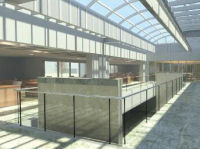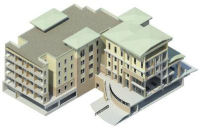Get The Picture
 Projects can go awry and cause costs to rise when a team member falls out of the loop and fails to understand the specifications and the budget requirements of the next step.
Projects can go awry and cause costs to rise when a team member falls out of the loop and fails to understand the specifications and the budget requirements of the next step.
Educational facility owners often feel out of their depth when they can’t make heads or tails of two-dimensional drawings and rough renderings that are submitted for approval by the project team.
Building Information Modeling solves this problem by creating three-dimensional exterior and interior images that leave little or nothing to the imagination. The software tool even has virtual cameras that enable users to fly through an interior, move from to room and peek in closets and corners. With a three-dimensional BIM design, what you see and what you approve is what you’ll get.
A BIM design contains more details than a two-dimensional CAD design, enabling the architect, construction manager and owner to better manage costs during design. With CAD drawings, an estimator goes over a set of plans after they are finished and often discovers that the project has gone over budget.
BIM enables everyone — owners, architects and contractors — to understand and participate in budget management decisions from the beginning of the project.
Consider this project. About two years ago, the University of Dallas allocated approximately $15 million to develop, design and construct a residence hall. The concept called for a four-story, 128,000-square-foot building with 298 beds in three-person suites, two-person rooms, single rooms and resident assistant rooms. Common areas for studying, relaxing and entertainment were also part of the design.
To meet the budget, the architect and contractor used BIM to size the rooms. Instead of schematics, BIM rendered full color three-dimensional images that university officials could evaluate and tweak.
 Once a BIM model was established, changes were relatively easy. If the design team decided to enlarge the bathroom in the suite, when the bathroom’s dimensions were altered, BIM would automatically update the dimensions of the rest of the suite and highlight potential conflicts that the architect would need to work out.
Once a BIM model was established, changes were relatively easy. If the design team decided to enlarge the bathroom in the suite, when the bathroom’s dimensions were altered, BIM would automatically update the dimensions of the rest of the suite and highlight potential conflicts that the architect would need to work out.
Costs were low enough to allow for some extras: detailing in the rooms, suites and common areas gave the hall a more residential, less institutional look and feel. In addition, it was possible to adjust the sizes of the bedrooms and suites to accommodate two additional multi-purpose common area rooms.
Nothing Is Easy
While the interior design fell easily into place, the architect and construction manager opined that the costs for the rooms endangered a four-pipe HVAC system requested by the university that was more expensive than common two-pipe systems.
University officials insisted that something would have to value engineered to pay for the system.
Meanwhile, the design team continued to look at how the building fit into the existing terrain of the site and how the soil conditions impacted the proposed structural systems. The geological survey indicated that the site rested on unusually active clay soil. The seasonal movement might be as much as 11 inches, which dictated an expensive pier and beam foundation anchored securely to the bedrock.
However, the soil problem became an opportunity. The architect and construction manager accomplished semi-underground parking for 65 cars by raising the first floor elevation by 1 foot and excavating the designed crawl space an additional 2 feet, thus creating a semi-underground parking area, at little added cost but great benefit to the project.
But, designers were still challenged to find a solution for the HVAC system. In a general meeting about the problem, the university’s facility manager asked if it would help to reduce the brickwork on the façade while still preserving the overall aesthetics of the building.
Two hours later, the architect had several new BIM treatments for the façade. Each reduced the brickwork without compromising the look of the building and saved about $200,000, enough to fund the four-pipe air conditioning system.
Today, the project is moving toward completion and the collaboration among the owner, architect and construction manager remains intact. The project is still on budget and even slightly ahead of schedule.
But that’s just the beginning of the BIM story. In coming years, as the entire project team grows more comfortable with BIM, as-built BIM models will become available to help facility managers maintain buildings. The system can be set up to flag day-to-day maintenance requirements, providing complete information about brands, specifications and warranties.
In a larger sense, if the roof needs to be replaced in 20 years, an architect can use the BIM model to fit the new roof to the existing structure in a fraction of the time it would take to update CAD drawings. If more efficient lighting systems come to market, BIM can quickly locate the fixtures appropriate for an upgrade, refine components and create a cost estimate.
BIM can bring all parties, including the owner, into a collaborative building process. It can speed design, estimating and construction work, while reducing costs related to conflicts and change orders and allowing for swift changes to solve problems that arise along the way.
